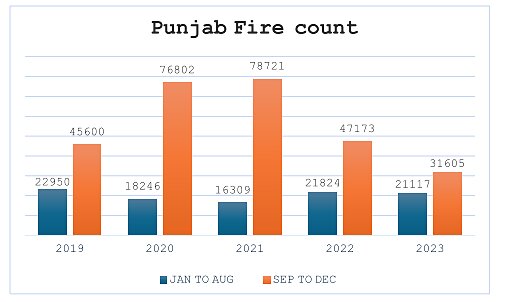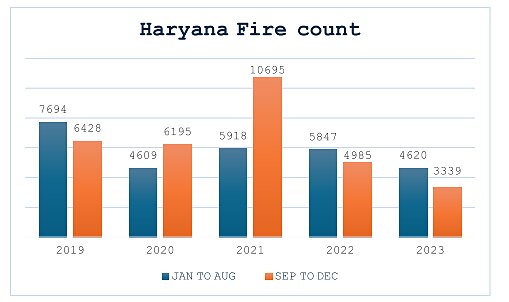
views
The number of stubble fires reported across Punjab and Haryana are decreasing after a record peak in 2021, but the numbers are still high enough to make the air more toxic every winter.
Both Punjab and Haryana, which together dispose of roughly 28 million tonnes of paddy straw in Kharif season, saw intense stubble burning activity in 2020 and 2021, but the numbers began to fall in 2022 and 2023 as per the satellite fire count data, possibly driven by improved stubble management practices or favourable climatic conditions, say experts.
According to the analysis of satellite fire counts data released by New Delhi-based Climate Trends, the total fire counts dropped from nearly 95,048 in Punjab in the year 2020 to 52,722 in 2023. In Haryana, the total fire counts reduced from 14,122 in 2019 to 7,959 in 2023, consistently higher from September to December.
“Most districts in Punjab saw a reduction to some extent, but the trend was not as uniform in Haryana, where some districts saw an increase in cases. There was a complex pattern of fluctuating fire activity in the state,” said lead author Palak Balyan from Climate Trends.
FIRE COUNTS INCREASED IN SOUTHERN HARYANA
In Punjab, Gurdaspur, Hoshiarpur, Muktsar and Patiala recorded the highest reduction, followed by Bathinda, Faridkot and Jalandhar. But the hotspot districts of Amritsar and Sangrur responsible for the highest number of stubble fires every year saw just a minor reduction, along with SAS Nagar. Punjab contributes the most to overall stubble burning cases every year due to the largest area under paddy cultivation.

“The shift to short-duration paddy varieties, and alternative stubble management techniques may have played a role in controlling the numbers to some extent. There has also been an increasing awareness among farmers about stubble burning management,” said Dr RN Padaria, Joint Director-Extension, Indian Agriculture Research Institute (IARI) who was present at the report release on Tuesday.
On the other hand, in Haryana, the northern districts — Ambala, Yamunanagar, Kurukshetra, Kaithal, Karnal, Fatehabad — showed a remarkable reduction in fire counts. But the stark increase in districts like Bhiwani, Faridabad, Hisar, Jhajjar, Gurgaon, Mewat, which are much closer to the national capital, was worrying, with the most dramatic rise in Gurgaon, as per the satellite data. The team used VIIRS S-NPP data which has a spatial resolution of 375 metres to track fire incidents.
STUBBLE BURNING STILL A SERIOUS CONCERN
Despite the downward trend, stubble burning continues to remain a persistent problem, deteriorating the air quality over Northwest India every winter and impacting the health of the people. As the harvesting season begins, the share of stubble burning to Delhi’s toxic air also increases, reaching a peak of 30-35 per cent in November.

“It has been a mixed trend so far. The reductions in some districts are significant, but the total fire count is still high. Delhi continues to struggle with poor air health. We need to understand the challenges faced by farmers and act accordingly,” said Aarti Khosla, Director, Climate Trends.
The data suggests the stubble fires peaked in 2021, which recorded the highest fire count in the dataset. In fact, the increase was dramatic in the winter season of 2020 and 2021. While the total fire counts surged to 6,195 in Haryana, they crossed 76,000 in Punjab during September to December 2020. It was even worse in 2021, when Punjab recorded 78,721 fire counts and Haryana saw nearly 10,695. The numbers began to fall in 2022 and 2023.
With 85 per cent of the farmers being mostly small and marginal, the agricultural experts also highlighted it would be a nearly “impossible task” to eliminate stubble burning all of a sudden.
“While the farm fires have seen a dip in numbers, we must also focus on the other sources that contribute to Delhi’s poor air all year round,” said Professor Sagnik Dey from Centre for Atmospheric Sciences, IIT Delhi, who was also part of the panel discussion at the IARI campus on Tuesday.















Comments
0 comment